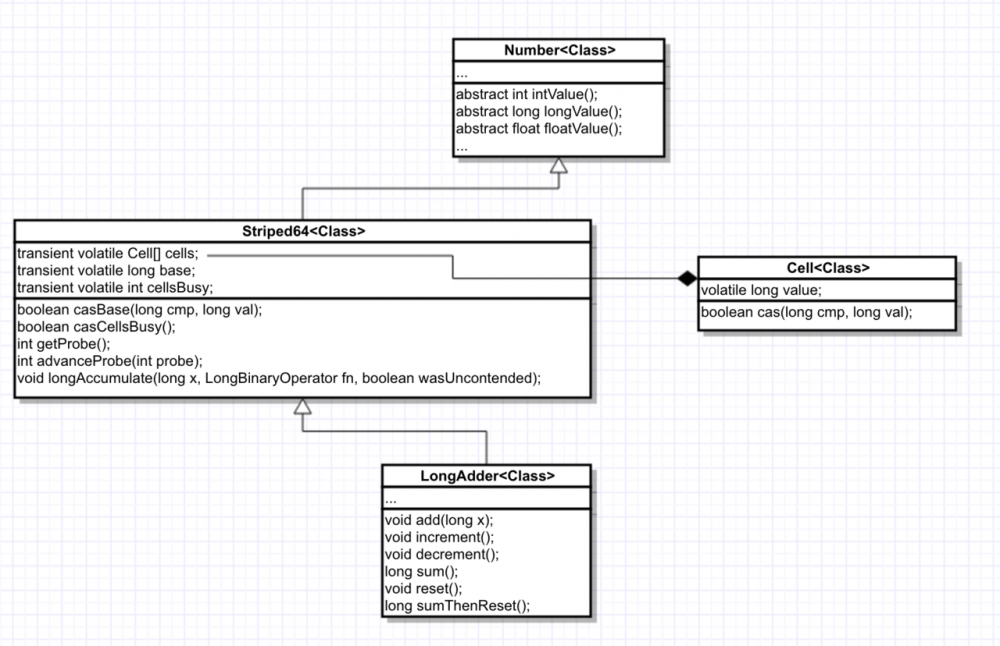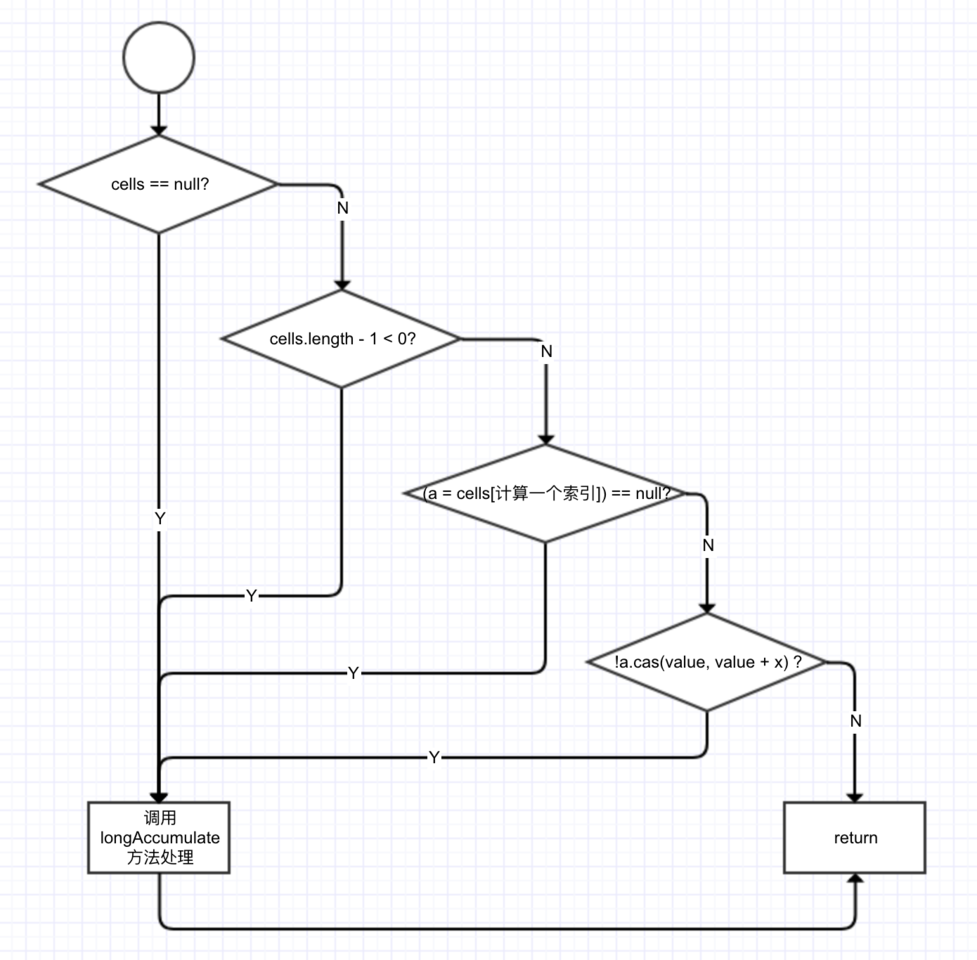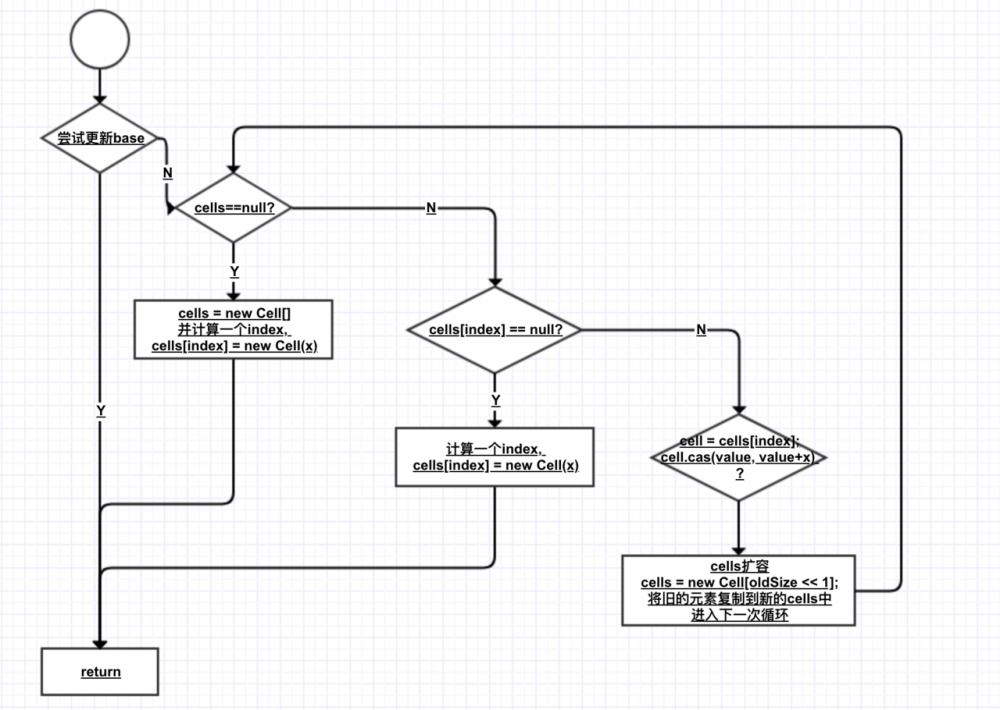深入剖析LongAdder是咋干活的
LongAdder是JDK8添加到JUC中的。它是一个线程安全的、比Atomic*系工具性能更好的"计数器"。
它提供的方法主要有下面这些:
| 方法名 | 说明 |
|---|---|
| void add(long x) | 将当前的value加x。 |
| void increment() | 将当前的value加1。 |
| void decrement() | 将当前的value减1。 |
| long sum() | 返回当前值。特别注意,在没有并发更新value的情况下,sum会返回一个精确值,在存在并发的情况下,sum不保证返回精确值。原因在下文中会说明。 |
| void reset() | 将value重置为0,可用于替代重新new一个LongAdder,但此方法只可以在没有并发更新的情况下使用。 |
| long sumThenReset() | 获取当前value,并将value重置为0。 |
0 LongAdder的类图

LongAdder本身没有成员变量,其值的变更实际上是由父类Striped64管理的。
Striped64通过两个成员变量来管理value,分别是base和cells,cells是一个数组,其元素是Striped64的内部类Cell的实现,Cell很简单,只记录一个value。
当LongAdder不存在并发访问的时候,会直接通过cas的方式更新base的值,存在并发访问时,会定位到某一个cell,修改cell的value。
最终,value = base + sum(cells)。
1 深挖add方法
add方法的作用是将当前的value值 + x。其实弄懂add方法后,increment方法和decrement自然就明白了,这两个方法里面调的其实就是add方法。
/**
* Equivalent to {@code add(1)}.
*/
public void increment() {
add(1L);
}
/**
* Equivalent to {@code add(-1)}.
*/
public void decrement() {
add(-1L);
}
复制代码
1.1 add方法的实现
其源码如下:
public void add(long x) {
Cell[] as; long b, v; int m; Cell a;
// cells和base即Striped64维护的实例变量
if ((as = cells) != null || !casBase(b = base, b + x)) { // #1
boolean uncontended = true;
if (as == null || (m = as.length - 1) < 0 ||
(a = as[getProbe() & m]) == null ||
!(uncontended = a.cas(v = a.value, v + x)))
longAccumulate(x, null, uncontended);
}
}
复制代码
初始状态下,cells==null,所以#1代码中,第一个条件一定是false,此时会通过casBase方法,以CAS的方式更新base值,且只有当cas失败时,才会走到if中。
啥时候会失败呢?存在竞争的时候。由此可以看出,当不存在竞争的时候,LongAdder是通过累加base值实现value的更新的。
当存在竞争的时候,LongAdder会尝试定位到其中的一个Cell,通过更新这个Cell的值来维护整体的value。这个过程如下:

longAccumulate方法在Striped64中定义。下面是当cells==null时的处理(暂时省略其他无关代码,能说明问题即可):
final void longAccumulate(long x, LongBinaryOperator fn, boolean wasUncontended) {
int h;
if ((h = getProbe()) == 0) {
ThreadLocalRandom.current(); // force initialization
h = getProbe();
wasUncontended = true;
}
boolean collide = false; // True if last slot nonempty
for (;;) {
Cell[] as; Cell a; int n; long v;
if ((as = cells) != null && (n = as.length) > 0) {
// ... 省略 ...
}
// cells == null 时的处理
else if (cellsBusy == 0 && cells == as && casCellsBusy()) {
boolean init = false;
try { // Initialize table
if (cells == as) {
Cell[] rs = new Cell[2];
rs[h & 1] = new Cell(x);
cells = rs;
init = true;
}
} finally {
cellsBusy = 0;
}
if (init)
break;
}
else if (casBase(v = base, ((fn == null) ? v + x :
fn.applyAsLong(v, x))))
break; // Fall back on using base
}
}
复制代码
cells==null时的处理在注释中已经标出。cellsBusy是用来控制并发修改cells的变量,初始值为0,通过casCellsBusy将cellsBusy的值从0更新为1。 然后,new了一个初始大小为2的Cell数组,new了一个Cell并将add的值作为初始值,然后计算一个cells的index,将这个Cell赋值进去。 最后,更新实例变量cells,并将cellsBusy重置为0。
cells!=null时,处理如下:
final void longAccumulate(long x, LongBinaryOperator fn, boolean wasUncontended) {
int h;
if ((h = getProbe()) == 0) {
ThreadLocalRandom.current(); // force initialization
h = getProbe();
wasUncontended = true;
}
boolean collide = false; // True if last slot nonempty
for (;;) {
Cell[] as; Cell a; int n; long v;
if ((as = cells) != null && (n = as.length) > 0) {
// 从cells中定位一个Cell,如果是null,就new一个Cell,并将x作为初始值
if ((a = as[(n - 1) & h]) == null) {
if (cellsBusy == 0) { // Try to attach new Cell
Cell r = new Cell(x); // Optimistically create
if (cellsBusy == 0 && casCellsBusy()) {
boolean created = false;
try { // Recheck under lock
Cell[] rs; int m, j;
if ((rs = cells) != null &&
(m = rs.length) > 0 &&
rs[j = (m - 1) & h] == null) {
rs[j] = r;
created = true;
}
} finally {
cellsBusy = 0;
}
if (created)
break;
continue; // Slot is now non-empty
}
}
collide = false;
}
else if (!wasUncontended) // CAS already known to fail
wasUncontended = true; // Continue after rehash
// 如果定位到的Cell!=null,尝试通过cas的方式更新这个cell维护的value。
// 如果更新成功,退出循环
else if (a.cas(v = a.value, ((fn == null) ? v + x :
fn.applyAsLong(v, x))))
break;
else if (n >= NCPU || cells != as)
collide = false; // At max size or stale
else if (!collide)
collide = true;
// 如果依然更新失败,扩容cells为原来的两倍,并将原来cells中的元素复制到新的cells中。
// PS: 通过cellsBusy控制并发
else if (cellsBusy == 0 && casCellsBusy()) {
try {
if (cells == as) { // Expand table unless stale
Cell[] rs = new Cell[n << 1];
for (int i = 0; i < n; ++i)
rs[i] = as[i];
cells = rs;
}
} finally {
cellsBusy = 0;
}
collide = false;
continue; // Retry with expanded table
}
h = advanceProbe(h);
}
else if (cellsBusy == 0 && cells == as && casCellsBusy()) {
// ... 省略 ...
}
// 上述过程都失败,尝试更新base的值。
else if (casBase(v = base, ((fn == null) ? v + x :
fn.applyAsLong(v, x))))
break; // Fall back on using base
}
}
复制代码
上述代码的大致原理如下:

1.2 它为啥比AtomicLong更加高效
以AtomicLong的getAndAdd方法做一下对比。下面是这个方法的源码:
/**
* Atomically adds the given value to the current value.
*
* @param delta the value to add
* @return the previous value
*/
public final long getAndAdd(long delta) {
return unsafe.getAndAddLong(this, valueOffset, delta);
}
public final long getAndAddLong(Object var1, long var2, long var4) {
long var6;
do {
var6 = this.getLongVolatile(var1, var2);
} while(!this.compareAndSwapLong(var1, var2, var6, var6 + var4));
return var6;
}
复制代码
AtomicLong的实现是通过无限循环cas的方式更新当前维护的值,可以想象,在并发足够大的情况下,cas的失败率会很高,这里循环次数剧增,造成CPU使用率飙高。
通过上文分析LongAdder.add(int x)的原理,LongAdder先尝试一次cas更新,如果失败会转而通过Cell[]的方式更新值,如果计算index的方式足够散列,那么在并发量大的情况下,多个线程定位到同一个cell的概率也就越低,这有点类似于分段锁的意思。
由此也可以分析出另一点,在并发量不大的情况下,二者的性能是没有多大差异的。
2 深挖sum方法
sum方法用于返回LongAdder当前的值。
2.1 sum方法的实现
sum方法的实现很简单,其实就是 base + sum(cells)。源码如下:
public long sum() {
Cell[] as = cells; Cell a;
long sum = base;
if (as != null) {
for (int i = 0; i < as.length; ++i) {
if ((a = as[i]) != null)
sum += a.value;
}
}
return sum;
}
复制代码
2.2 为啥在并发情况下sum的值不精确
由上述源码可以发现,sum执行时,并没有限制对base和cells的更新。也就是说,对LongAdder的最后一次更新not happens-before 最近的一次读取。
首先,最终返回的sum局部变量,初始被复制为base,而最终返回时,很可能base已经被更新了,而此时局部变量sum不会更新,造成不一致。
其次,这里对cell的读取也无法保证是最后一次写入的值。
所以,sum方法在没有并发的情况下,可以获得正确的结果。
3 深挖reset方法
用于初始化base和cells数组,将值重置为0。
3.1 reset方法的实现
源码如下:
public void reset() {
Cell[] as = cells; Cell a;
base = 0L;
if (as != null) {
for (int i = 0; i < as.length; ++i) {
if ((a = as[i]) != null)
a.value = 0L;
}
}
}
复制代码
其实就是将base和cells数组挨个设置成0。
3.2 为啥不可以在并发情况下使用
因为reset方法并不是原子操作,它先将base重置成0,假设此时CPU切走执行sum,此时的sum就变成了减去base后的值。
也就是说,在并发量大的情况下,执行完此方法并不能保证其他线程看到的是重置后的结果。所以要慎用。
4 总结
在实际工作中,可根据LongAdder和AtomicLong的特点来使用这两个工具。 当需要在高并发下有较好的性能表现,且对值的精确度要求不高时,可以使用LongAdder(例如网站访问人数计数)。 当需要保证线程安全,可允许一些性能损耗,要求高精度时,可以使用AtomicLong。












![[HBLOG]公众号](https://www.liuhaihua.cn/img/qrcode_gzh.jpg)

